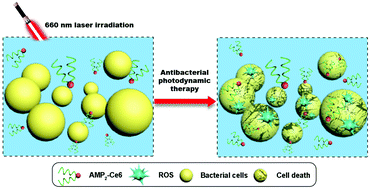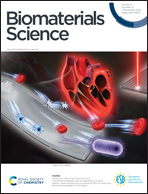Antibacterial photodynamic peptides for staphylococcal skin infection†
Abstract
As the barrier between the human body and the outside world, the skin is vulnerable to pathogenic microorganisms, especially when suffering from skin injuries such as burns. Staphylococcus aureus remains the most common type of bacteria that infects humans, and the surging drug resistance poses a major threat to the treatment of these infections. Here we report the development of antibacterial photodynamic peptides (APPs) that are constructed based on the covalent conjugation of an antibacterial peptide and the photosensitizer chlorin e6 (Ce6). Peptide conjugation significantly increases the photo-stability of Ce6, while retaining its ROS generation capability under photo-irradiation. The APPs combine the antibacterial activity of the peptide and the photodynamic therapy of Ce6, and under the assistance of mild laser irradiation, can eradicate bacterial infection and inhibit the formation of bacterial biofilms ex vivo. One of the APPs, (GKRWWKWWRR)2KGGK(Ce6)G, AMP2-Ce6, with Ce6 conjugated with the dimeric peptide, showed exceptional antibacterial activity with an MIC90 value around 3.2 μM without photo-irradiation and <0.1 μM with short light treatment. Supported by a hydrogel matrix composed of gelatin and recombinant human collagen III protein (rhCol III) mimicking the extracellular matrix of skin cells, AMP2-Ce6 efficiently accelerated the healing rate of wounds and improved the quality of wound healing in mice infected with Staphylococcus aureus. Altogether, here we report the development of antibacterial photodynamic peptides, which together with a regenerative matrix material exhibit an added effect against staphylococcal skin infection. This composite material holds promise as a new type of wound dressing material for skin infection and wound healing.



 Please wait while we load your content...
Please wait while we load your content...